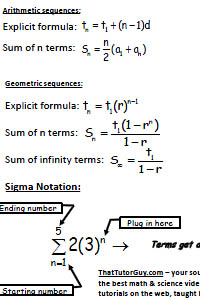Sequences & SeriesMy tutoring students are often rattled by this chapter, but the confusion usually melts away once they see how arithmetic and geometric sequences are "the same but different". It's just two different sets of equations, but if you've got them at your fingertips (click on thumbnail to the right to see a pdf of all the formulas for sequences).Also in this chapter there's a whole video *just* about SAT sequence questions since they're so common. Most students won't still remember their sequence formulas when the SAT comes around, but that's actually okay because SAT questions are usually designed so that the formulas wouldn't help you anyway. |
|

